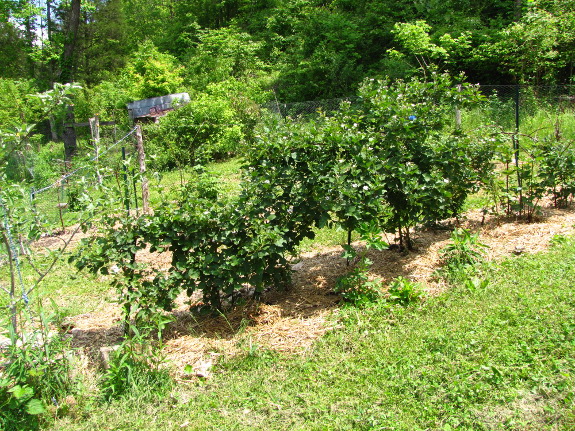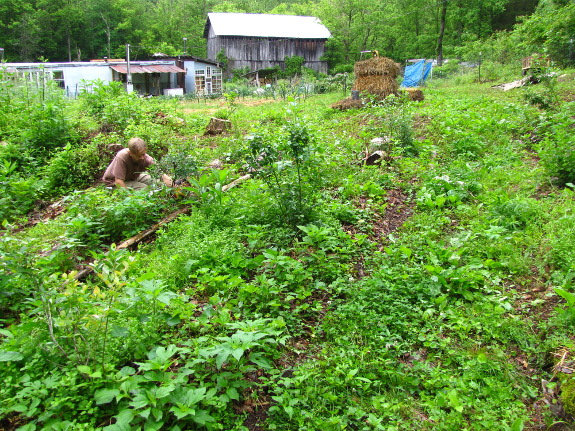
Planning garden beds on hilly land

Most permaculture texts
admonish you to plan beds so that they run perpendicular to the slope,
so why did I plant my bramble patch in the opposite
orientation? The real answer is --- because it's one of the first
things I put in when we moved here and I didn't know any better.
However, in retrospect, there are reasons to fly in the face of
permaculture teachings and site your garden beds parallel to the slope.

But first, why do the
books tell you to make your rows run like contour lines on a map, as is
shown in our blueberry patch above? This type of orientation
prevents erosion --- gullies can form when heavy rains hit tilled soil
with rows running from the top to the bottom of a hill. Even with
a permanently mulched, no-till garden, it can be handy to keep your
rows perpendicular to the slope since the raised beds and aisles
together act like swales, slowing water and letting
more of the precious liquid soak into the root zone of your plants.
 But what if you live in a
really wet climate and don't want all that water swamping your plants'
roots? I'm actually glad that I planted the bramble patch in a
counterintuitive fashion since that area has very high groundwater that
tends to pool just downhill. If I'd created swales with my rows
of berries, the waterlogged soil might have been too much for my
berries to handle.
But what if you live in a
really wet climate and don't want all that water swamping your plants'
roots? I'm actually glad that I planted the bramble patch in a
counterintuitive fashion since that area has very high groundwater that
tends to pool just downhill. If I'd created swales with my rows
of berries, the waterlogged soil might have been too much for my
berries to handle.
On the other hand, my
blueberry patch is more well-drained (if less well-weeded --- Mark's
currently working on that). We don't irrigate our woody plants,
so the blueberries can only drink the rain that falls from above and
gets stored in their mulched beds. With dry, well-drained soil,
conventional wisdom makes sense.
I'd be curious to hear
from others who have intentionally planned garden beds perpendicular to a
slope. What did you think of the experiment?
Want more in-depth information? Browse through our books.
Or explore more posts by date or by subject.
About us: Anna Hess and Mark Hamilton spent over a decade living self-sufficiently in the mountains of Virginia before moving north to start over from scratch in the foothills of Ohio. They've experimented with permaculture, no-till gardening, trailersteading, home-based microbusinesses and much more, writing about their adventures in both blogs and books.
Want to be notified when new comments are posted on this page? Click on the RSS button after you add a comment to subscribe to the comment feed, or simply check the box beside "email replies to me" while writing your comment.

I just put in a row of grapes and a row of raspberries. I ran them downhill on purpose. The reason I did this is the hill runs downhill from East to West. If I planted them along contour lines, the Southern plants would have shaded the more Northern plants.
If I were to follow permaculture guidelines, I wouldn't have a raspberry bed. The raspberries and grapes would be fit in among the other plants. For ease of picking, I prefer to keep them all together.
I highly recommend Sepp Holzer's Permaculture - I am reading it now, and I am finding lots of practical advice. Sepp uses what he calls 'hugelkultur', piles of rotting deadwood, as a great way to make raised beds that 1) don't get waterlogged because they allow water to seep underneath, and 2) don't dry out because they have rotting wood at their core.
Sepp and many other contemporary permies don't advocate absolutely parallel/perpendicular swales or hugels, this sort of detail is very site-specific as you recognized. Even if I wanted to conserve water, I would do more of a herring-bone pattern, to slow the flow of water without causing it to pool.
I would also say that permaculture is a way of creating functional systems on your land, so whenever I read about some tree guild that works in the Austrian Alps (where Sepp's farm is), or Arizona, or western Washington, I understand they have different context and goals from me. I am not too far from you, though I am central VA without lots of hills and mountains. Though we can get a lot of rain at times, we can also go long stretches without, so I use hugelkultur and woody mulch materials for water conservation. I am trying to figure out how to create cooler microclimates, which is not easy info to find in many permaculture texts!
Love your berry patch!
Chris --- I enjoyed Sepp Holzer's Permaculture too. (You can read my lunchtime series about it here.) We've been using hugelkultur (or my variant of it) in a spot with waterlogged soil for years --- it works great!
I think that really good permaculture practitioners do a great job of tweaking design ideas to suit their site, but I've noticed lots of beginners blindly try to carry out those ideas, then falling on their faces. (Especially when they're reading books by Australian permaculturalists but experimenting in a cooler, wetter climate.) I'd love it if all of these books came with discussions of situations when certain techniques make sense (and when they don't) to save us all a lot of trial and error.